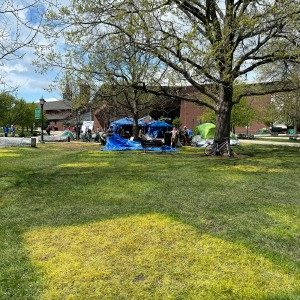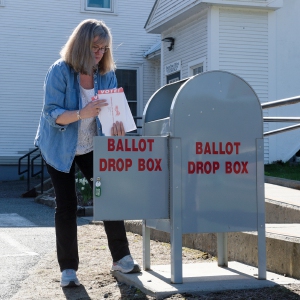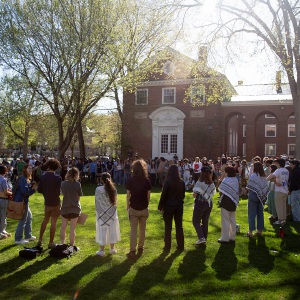A Look Back: The epic ice storm of 1998
| Published: 01-22-2023 5:53 PM |
Twenty-five years ago, a storm struck parts of the Upper Valley, weighing down trees under a coating of ice and knocking out power for days.
Two weather fronts stalled over the Northeast for three to four days in early January 1998, and it fell not as snow but as drenching rain.
“The storm brought a tremendous amount of precipitation,” meteorologist Steve Maleksi of the Fairbanks Museum in St. Johnsbury, Vt., said in a 1998 Valley News story. “We got more in four days than we usually get during the entire month in January.”
According to the Associated Press at the time, the month was the wettest since the National Weather Service began keeping records in 1884. February was the third warmest February on record and March set a new record high temperature for the month: 88 degrees.
Upper Valley towns hit hardest by accumulating ice were at higher elevations. New London was one at the tip of the storm’s spear, one of 16 New Hampshire communities that declared a state of emergency due to the amount of trees and power lines that were down.
“It’s a white disaster zone,” said Bob Nelson, New London’s emergency management director at the time. The NH Department of Transportation had 15 trucks and 35 men — five times the size of a crew that normally works in New London — trying to keep roads open for emergency personnel.
After struggling with no heat or electricity for days, the Jerome family decided to leave their New London homes to stay at a shelter in the Wilmot Fire Station. Emma Jerome said they wanted to get hot food into her three grandchildren and were tired of trying to heat soup over candles. “No water, no food, no heat, no toilet and no coffee,” she said to a Valley News reporter at the time.
The Keat family in Grantham came up with a creative solution to cope with the small wood stove heating their large house. As sleeping became uncomfortable, on the third night they set up tents for parents and children in front of the stove.
Article continues after...
Yesterday's Most Read Articles
“It was kind of fun for all of us,” Faye Keat said in a 1998 Valley News story. “It was like sleeping out in the forest, since we still had our Christmas tree up.”
Trees, particularly hardwoods, were hit hard by the layers of ice. An estimated 500,000 acres — about 10% of Vermont’s forests — were damaged, state forestry officials said at the time.
“It looks like a dinosaur came along and just munched on the tops of these trees,” forester Paul Harwood said in late January 1998 while surveying a stand of maples trees in Tunbridge. “You don’t have to be a forester to know this isn’t the way it’s supposed to be.”
Kathy Jones, a research scientist at the Cold Regions Research and Engineering Laboratory in Hanover, calculated at the time that a maple tree 20 to 30 feet high with a trunk 12 inches in diameter that got a half-inch coating would be weighed down with eight tons of ice.
“My guess is the tree would fall down before it could get that much ice on it,” Jones said to the Valley News. “About a quarter-inch on all the limbs and branches will bring a tree down.”
“I have never seen damage like this,” said Larry Myott, maple specialist for the University of Vermont Extension service, told the Valley News. “The long-range effect doesn’t look good,” he said, “because you can’t tap a badly damaged sugarbush.”
Crews were at risk while restoring power after the storm. A lineman for NH Electric Co-Op, Alan Noyes, of Sunapee, was pinned during the storm by a tree that snapped while he was clearing it from an electric line in Sunapee Heights. Noyes became a quadriplegic due to a severe injury to his spinal cord. “You do everything you can to avoid this, but when a tree doesn’t behave the way mechanics say it would, there’s not much you can do,” said Co-op spokesman Ray Gosney in a Jan. 10, 1998, Associated Press report. “We’re all praying for him now.”
Later in the month, a contingent from Granite State Electric in Lebanon worked for at least two weeks with crews from as far away as Detroit to bring power back in rural Quebec. “We were drafted,” said engineer Tim Deppmeyer, of Claremont, part of an effort to bring power back to 175,000 in Hydro-Quebec’s coverage area.
In a February 1998 Valley News story about their work, Bobby Woodward, of Lebanon, was asked to measure the disaster against other jobs he had been on in his 32 years as a lineman. “Multiply any job we’ve been on by 10 or 20 — I don’t think anybody can put a number on it.”
Geoff Hansen can be reached at ghansen@vnews.com or 603-727-3247.

 Students take down pro-Palestinian encampment at UVM
Students take down pro-Palestinian encampment at UVM Sharon voters turn back proposal to renovate school
Sharon voters turn back proposal to renovate school Dartmouth administration faces fierce criticism over protest arrests
Dartmouth administration faces fierce criticism over protest arrests
